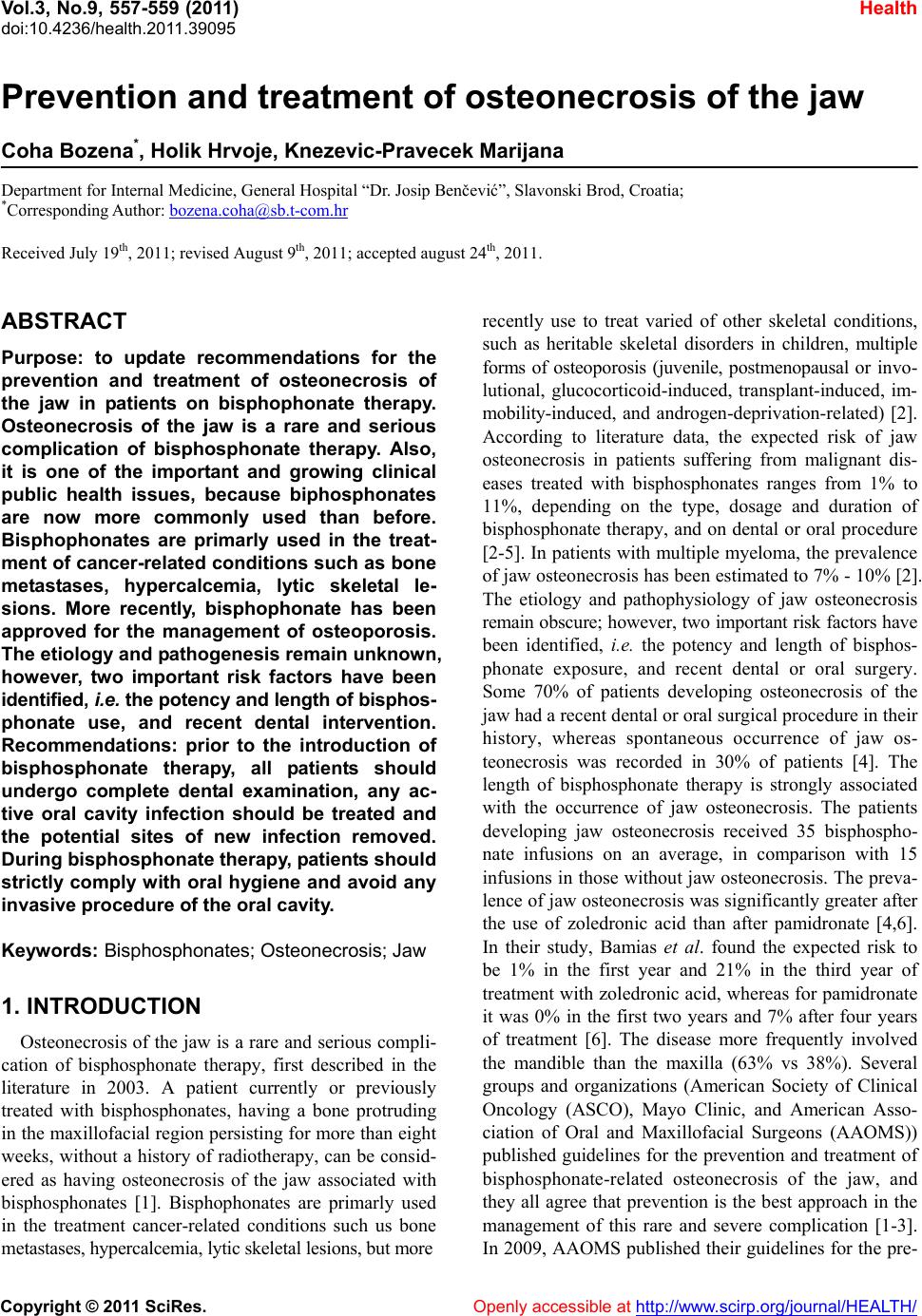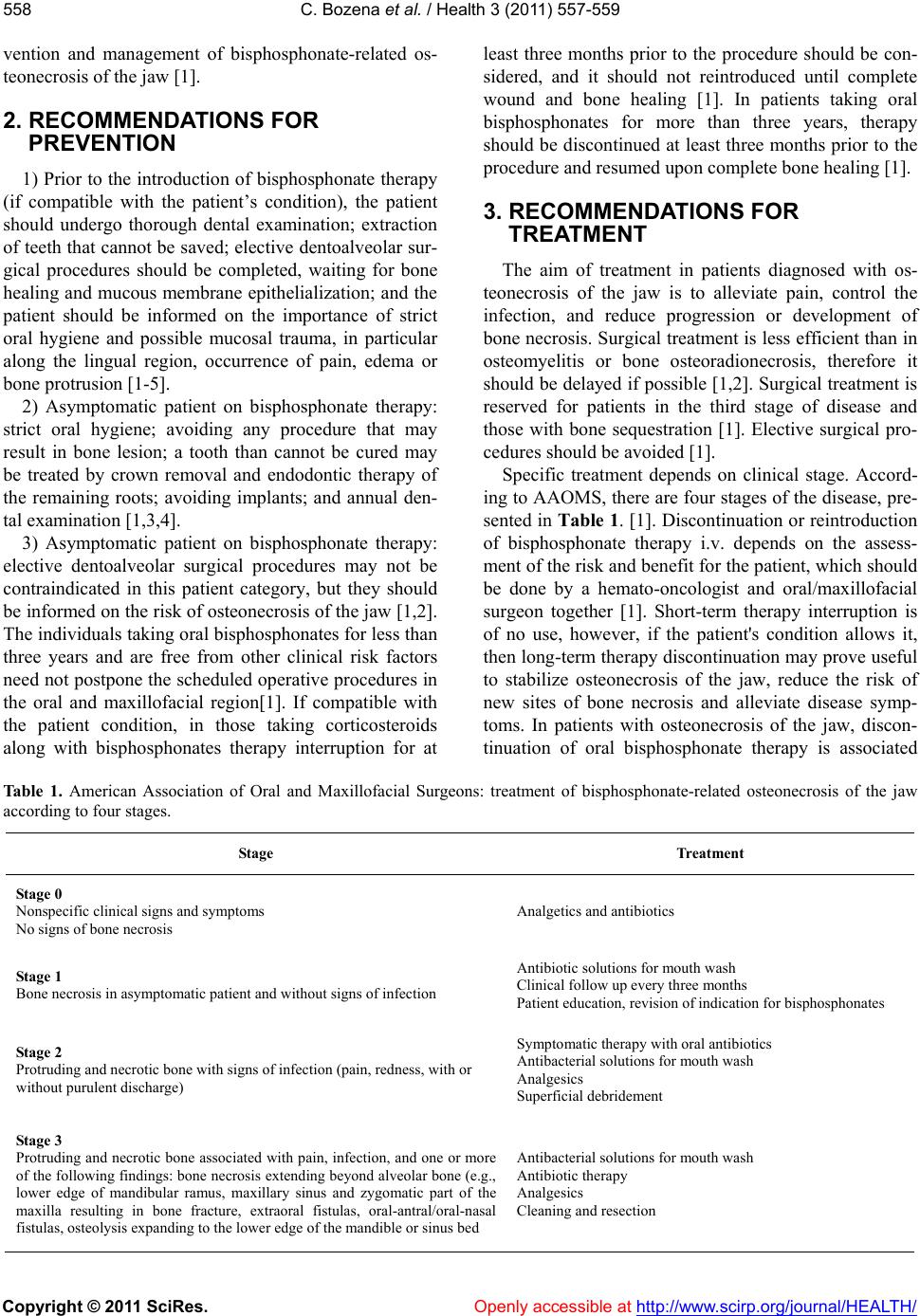Paper Menu >>
Journal Menu >>
 Vol.3, No.9, 557-559 (2 doi:10.4236/health.2011.39095 C opyright © 2011 SciRes. Openly accessible at http://www.scirp.org/journal/HEALTH/ 011) Health Prevention and treatment of osteonecrosis of the jaw Coha Bozena*, Holik Hrvoje, Knezevic-Pravecek Marijana Department for Internal Medicine, General Hospital “Dr. Josip Benčević”, Slavonski Brod, Croatia; *Corresponding Author: bozena.coha@sb.t-com.hr Received July 19th, 2011; revised August 9th, 2011; accepted august 24th, 2011. ABSTRACT Purpose: to update recommendations for the prevention and treatment of osteonecrosis of the jaw in patients on bisphophonate therapy. Osteonecrosis of the jaw is a rare and serious complication of bisphosphonate therapy. Also, it is one of the important and growing clinical public health issues, because biphosphonates are now more commonly used than before. Bisphophonates are primarly used in the treat- ment of cancer-related conditions such as bone metastases, hypercalcemia, lytic skeletal le- sions. More recently, bisphophonate has been approved for the management of osteoporosis. The etiology and pathogenesis remain unknown, however, two important risk factors have been identified, i.e. the potency and length of bisp hos- phonate use, and recent dental intervention. Recommendations: prior to the introduction of bisphosphonate therapy, all patients should undergo complete dental examination, any ac- tive oral cavity infection should be treated and the potential sites of new infection removed. During bisphosphonate therapy, patients should strictly comply with oral hygiene and avoid any invasive procedure of the oral cavity. Keywords: Bisphosphonates; Osteonecrosis; Jaw 1. INTRODUCTION Osteonecrosis of the jaw is a rare and serious compli- cation of bisphosphonate therapy, first described in the literature in 2003. A patient currently or previously treated with bisphosphonates, having a bone protruding in the maxillofacial region persisting for more than eight weeks, without a history of radiotherapy, can be consid- ered as having osteonecrosis of the jaw associated with bisphosphonates [1]. Bisphophonates are primarly used in the treatment cancer-related conditions such us bone metastases, hypercalcemia, lytic skeletal lesions, but more recently use to treat varied of other skeletal conditions, such as heritable skeletal disorders in children, multiple forms of osteoporosis (juvenile, postmenopausal or invo- lutional, glucocorticoid-induced, transplant-induced, im- mobility-induced, and androgen-deprivation-related) [2]. According to literature data, the expected risk of jaw osteonecrosis in patients suffering from malignant dis- eases treated with bisphosphonates ranges from 1% to 11%, depending on the type, dosage and duration of bisphosphonate therapy, and on dental or oral procedure [2-5]. In patients with multiple myeloma, the prevalence of jaw osteonecrosis has been estimated to 7% - 10% [2]. The etiology and pathophysiology of jaw osteonecrosis remain obscure; however, two important risk factors have been identified, i.e. the potency and length of bisphos- phonate exposure, and recent dental or oral surgery. Some 70% of patients developing osteonecrosis of the jaw had a recent dental or oral surgical procedure in their history, whereas spontaneous occurrence of jaw os- teonecrosis was recorded in 30% of patients [4]. The length of bisphosphonate therapy is strongly associated with the occurrence of jaw osteonecrosis. The patients developing jaw osteonecrosis received 35 bisphospho- nate infusions on an average, in comparison with 15 infusions in those without jaw osteonecrosis. The preva- lence of jaw osteonecrosis was significantly greater after the use of zoledronic acid than after pamidronate [4,6]. In their study, Bamias et al. found the expected risk to be 1% in the first year and 21% in the third year of treatment with zoledronic acid, whereas for pamidronate it was 0% in the first two years and 7% after four years of treatment [6]. The disease more frequently involved the mandible than the maxilla (63% vs 38%). Several groups and organizations (American Society of Clinical Oncology (ASCO), Mayo Clinic, and American Asso- ciation of Oral and Maxillofacial Surgeons (AAOMS)) published guidelines for the prevention and treatment of bisphosphonate-related osteonecrosis of the jaw, and they all agree that prevention is the best approach in the management of this rare and severe complication [1-3]. In 2009, AAOMS published their guidelines for the pre-  C. Bozena et al. / Health 3 (2011) 557-559 Copyright © 2011 SciRes. Openly accessible at http://www.scirp.org/journal/HEALTH/ 558 vention and management of bisphosphonate-related os- teonecrosis of the jaw [1]. 2. RECOMMENDATIONS FOR PREVENTION 1) Prior to the introduction of bisphosphonate therapy (if compatible with the patient’s condition), the patient should undergo thorough dental examination; extraction of teeth that cannot be saved; elective dentoalveolar sur- gical procedures should be completed, waiting for bone healing and mucous membrane epithelialization; and the patient should be informed on the importance of strict oral hygiene and possible mucosal trauma, in particular along the lingual region, occurrence of pain, edema or bone protrusion [1-5]. 2) Asymptomatic patient on bisphosphonate therapy: strict oral hygiene; avoiding any procedure that may result in bone lesion; a tooth than cannot be cured may be treated by crown removal and endodontic therapy of the remaining roots; avoiding implants; and annual den- tal examination [1,3,4]. 3) Asymptomatic patient on bisphosphonate therapy: elective dentoalveolar surgical procedures may not be contraindicated in this patient category, but they should be informed on the risk of osteonecrosis of the jaw [1,2]. The individuals taking oral bisphosphonates for less than three years and are free from other clinical risk factors need not postpone the scheduled operative procedures in the oral and maxillofacial region[1]. If compatible with the patient condition, in those taking corticosteroids along with bisphosphonates therapy interruption for at least three months prior to the procedure should be con- sidered, and it should not reintroduced until complete wound and bone healing [1]. In patients taking oral bisphosphonates for more than three years, therapy should be discontinued at least three months prior to the procedure and resumed upon complete bone healing [1]. 3. RECOMMENDATIONS FOR TREATMENT The aim of treatment in patients diagnosed with os- teonecrosis of the jaw is to alleviate pain, control the infection, and reduce progression or development of bone necrosis. Surgical treatment is less efficient than in osteomyelitis or bone osteoradionecrosis, therefore it should be delayed if possible [1,2]. Surgical treatment is reserved for patients in the third stage of disease and those with bone sequestration [1]. Elective surgical pro- cedures should be avoided [1]. Specific treatment depends on clinical stage. Accord- ing to AAOMS, there are four stages of the disease, pre- sented in Table 1. [1]. Discontinuation or reintroduction of bisphosphonate therapy i.v. depends on the assess- ment of the risk and benefit for the patient, which should be done by a hemato-oncologist and oral/maxillofacial surgeon together [1]. Short-term therapy interruption is of no use, however, if the patient's condition allows it, then long-term therapy discontinuation may prove useful to stabilize osteonecrosis of the jaw, reduce the risk of new sites of bone necrosis and alleviate disease symp- toms. In patients with osteonecrosis of the jaw, discon- tinuation of oral bisphosphonate therapy is associated Table 1. American Association of Oral and Maxillofacial Surgeons: treatment of bisphosphonate-related osteonecrosis of the jaw according to four stages. Stage Treatment Stage 0 Nonspecific clinical signs and symptoms No signs of bone necrosis Analgetics and antibiotics Stage 1 Bone necrosis in asymptomatic patient and without signs of infection Antibiotic solutions for mouth wash Clinical follow up every three months Patient education, revision of indication for bisphosphonates Stage 2 Protruding and necrotic bone with signs of infection (pain, redness, with or without purulent discharge) Symptomatic therapy with oral antibiotics Antibacterial solutions for mouth wash Analgesics Superficial debridement Stage 3 Protruding and necrotic bone associated with pain, infection, and one or more of the following findings: bone necrosis extending beyond alveolar bone (e.g., lower edge of mandibular ramus, maxillary sinus and zygomatic part of the maxilla resulting in bone fracture, extraoral fistulas, oral-antral/oral-nasal fistulas, osteolysis expanding to the lower edge of the mandible or sinus bed Antibacterial solutions for mouth wash Antibiotic therapy Analgesics Cleaning and resection  C. Bozena et al. / Health 3 (2011) 557-559 Copyright © 2011 SciRes. Openly accessible at http://www.scirp.org/journal/HEALTH/ 559559 with gradual improvement of clinical status. A 6- to 12-month interruption may lead to spontaneous seques- tration or healing following surgical intervention [1]. REFERENCES [1] Ruggiero, S.L., Dodson, T.B., Assael, L.A., Landesberg, R., Marx, R.E. and Mehrotra, B. (2009) American Association of Oral and Maxillofacial Surgeons position paper on bisphosphonate-related osteonecrosis of the jaw—2009 update. Australian Endodontic Journal, 35, 119-130. [2] Drake, M.T., Clarke, B.L. and Khosla, S. (2008) Bisphosphonates: Mechanism of action and role in clini- cal practice. Mayo Clinic Proceedings, 83, 1032-1045. [3] Kyle, R.A., Yee, G.C., Somerfield, M.R., Flynn, P.J., Halabi, S., Jagannath, S., Orlowski, R.Z., Roodman, D.G., Twilde, P. and Anderson, K. (2007) American Society of Clinical Oncology 2007 clinical practice guideline up- date on the role of bisphosphonates in multiple myeloma. Journal of Clinical Oncology, 25, 2464-2472. [4] Lacy, M.Q., Dispenzieri, A., Gertz, M.A., Greipp, P.R., Gollbach, K.L., Hayman, S.R., Kumar, S., Lust, J.A., Rajkumar, S.V., Russell, S.J., Witzig, T.E., Zeldenrust, S.R., Dingli, D., Bergsagel, P.L., Fonseca, R., Reeder, C.B., Stewart, A.K., Roy, V., Dalton, R.J., Carr, A.B., Kademani, D., Keller, E.E., Viozzi, C.F. and Kyle, R.A. (2006) Mayo clinic consensus statement for the use of bisphosphonates in multiple myeloma. Mayo Clinic Pro- ceedings, 81, 1047-1053. [5] Terpos, E., Sezer, O., Croucher, P.I., García-Sanz, R., Boccadoro, M., San Miguel, J., Ashcroft, J., Bladé, J., Cavo, M., Delforge, M., Dimopoulos, M.A., Facon, T., Macro, M., Waage, A. and Sonneveld, P. (2009) The use of bisphosphonates in multiple myeloma: Recommenda- tions of an expert panel on behalf of the European Mye- loma Network. Annals of Oncology, 20, 1303-1317. [6] Bamias, A., Kastritis, E., Bamia, C., et al. (2005) Os- teonecrosis of the yaw in cancer after treatment with bisphosphonates: incidence and risk factors. Journal of Clinical Oncology, 23, 8580-8587. |

